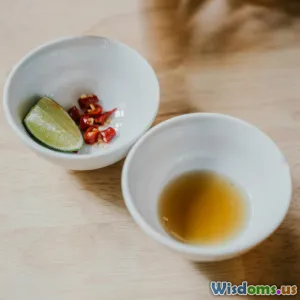
Debunking Myths About MSG in Everyday Cooking
8 min read Discover the truth behind MSG in cooking and dispel common myths that fuel its undeserved bad reputation. (0 Reviews)
Debunking Myths About MSG in Everyday Cooking
Introduction: The Unseen Flavor Ally
Monosodium glutamate, widely known as MSG, has long been a controversial ingredient in kitchens worldwide. Despite its ubiquitous use in enhancing flavors, MSG has earned a reputation wrapped in myths and misconceptions. Many home cooks and consumers remain wary of adding it to their recipes, thanks to decades of misinformation and fear-mongering headlines. But what if we told you MSG is not the villain it's often made out to be? Through a focused journey into the science and myths surrounding MSG, this article aims to demystify the ingredient and reveal why MSG deserves a spot in your culinary arsenal.
What is MSG?
MSG is the sodium salt of glutamic acid, a naturally occurring non-essential amino acid found in many foods such as tomatoes, cheese, mushrooms, and even breast milk. It provides the umami taste, often described as a savory or meaty flavor, one of the five basic tastes identified by scientists, alongside sweet, sour, salty, and bitter.
Since its commercialization in the early 20th century, MSG has been used extensively in Asian cuisine, processed foods, and restaurants worldwide. It boosts the natural flavors of dishes without adding overpowering taste, acting as a flavor enhancer rather than a flavor itself.
Myth #1: MSG Causes Headaches and Allergic Reactions
The claim that MSG induces headaches or allergies stems from what was once labeled “Chinese Restaurant Syndrome”(CRS) after reports of discomfort following consumption of Chinese food rich in MSG emerged in the 1960s. However, extensive research by authoritative bodies like the U.S. Food and Drug Administration (FDA) and the World Health Organization (WHO) has found no consistent scientific evidence supporting a link between MSG and adverse reactions.
The Science:
- In a study published in The Journal of Headache and Pain (2014), researchers found only a very small percentage of people reported symptoms from consuming high doses of MSG, often under controlled conditions far beyond typical culinary use.
- The FDA classifies MSG as "generally recognized as safe" (GRAS).
- People might confuse reactions like headaches from MSG with other factors present in food or psychosomatic responses due to preconceived beliefs.
The Real Culprits:
Some processed foods contain high sodium levels and other additives that might trigger sensitivity. Additionally, a large amount of food itself, heavy spices, or even food allergies unrelated to MSG are often the actual causes of discomfort.
Myth #2: MSG is an Artificial Chemical Harmful to Your Body
While MSG used in food additives undergoes industrial manufacturing, the compound itself is chemically identical to naturally occurring glutamate in foods.
Natural vs. Added MSG:
- Tomatoes and aged cheeses contain glutamate naturally, often in higher concentrations than in processed MSG.
- The body doesn't distinguish between glutamate from natural sources or added MSG; both are metabolized similarly.
What About Processing?
MSG production typically involves fermentation using natural starch or sugar sources with bacteria, much like other common food products such as vinegar and yogurt. Thus, it is not a synthetic chemical concoction but rather a product of natural processes.
Myth #3: Cooking with MSG Masks Poor-Quality Ingredients
A common misconception is that using MSG is a shortcut that covers up inferior ingredients.
Flavor Enhancer, Not a Mask
MSG enhances the inherent flavors in food by stimulating savory taste receptors on the tongue, helping dishes taste richer and more satisfying.
Renowned chefs like Gordon Ramsay and David Chang openly use MSG to amplify flavors without bias. Properly used MSG elevates the natural taste profiles without making a poor ingredient good by itself; it enhances, not replaces.
Example:
Adding a pinch of MSG to a simple chicken soup can deepen the brothy savoriness, making the dish feel heartier and more satisfying with minimal sodium.
Myth #4: MSG Is Loaded with Sodium and Bad for Heart Health
People often compare MSG to table salt due to the presence of sodium.
Sodium Content Comparison:
- MSG contains about 12% sodium by weight compared to 39% in table salt.
- Because it enhances flavor, less salt may be needed when MSG is added.
Several studies note that MSG usage can lead to reduced sodium consumption, beneficial for hypertension management. The American Heart Association acknowledges that reducing salt intake is important, and MSG can be a useful tool to maintain palatability while cutting salt.
Real-World Insights: MSG in Global Cuisine
Many cultures have been using naturally glutamate-rich ingredients long before additive MSG existed:
- Japan: Kombu seaweed used in dashi broth is a rich natural source of glutamate.
- Italy: Parmesan cheese and ripe tomatoes boost umami.
- Korea: Fermented soybean paste (doenjang) benefits from natural glutamates.
The widespread acceptance and traditional use of these ingredients emphasize that umami and glutamate are universally cherished flavor elements.
How to Use MSG Wisely in Everyday Cooking
- Use sparingly: Start with 1/4 teaspoon for a family-sized dish and adjust.
- Combine with salt reduction: MSG can substitute part of the salt to maintain flavor with less sodium.
- Use in savory dishes: soups, stews, sauces, grilled vegetables, and meats.
- Avoid in sweet dishes or items sensitive to strong umami notes.
Conclusion: Embrace MSG as a Safe Culinary Tool
After decades of misunderstanding, the truth about MSG is clear. It is a naturally derived, scientifically validated flavor enhancer that is safe for the vast majority of people when used appropriately. Dispelling myths about headaches, allergic reactions, and its chemical nature allows cooks to focus on flavor innovation without fear.
Cookbooks, chefs, and health authorities increasingly support MSG’s usage to reduce excess sodium and enrich taste naturally. By opening your kitchen to MSG, you invite an ancient element of the savory taste spectrum to enhance everyday meals with authenticity and depth.
Next time you cook, consider adding a pinch of MSG to unlock new dimensions of flavor — and cook confidently, free from outdated myths.
Rate the Post
User Reviews
Popular Posts



















